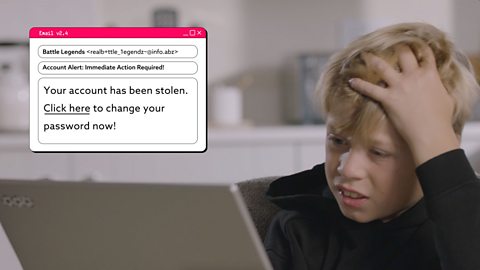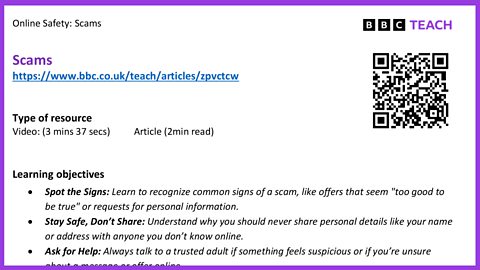This video was produced in partnership with Childnet for Safer Internet Day 2025, which is based around the theme: Too good to be true? Protecting yourself and others from scams online. Find free supporting resources to use alongside the video on the UK Safer Internet Centre website. See a British Sign Language version of the video below on this page.
Safer Internet Day 2025 – Live Lesson
Join us at 11:00 on Tuesday, 11 February to help spot the scams in this interactive Live Lesson.
I don't need to tell you. The internet can be a super exciting place full of fun opportunities to explore, play games, and connect with friends. Online shopping or competitions to win prizes can be great when they're real, but it's important to stop and double-check before believing everything you see.
Sadly, sometimes people might be trying to trick you into giving them personal information or money. These are called scams and I'm going to tell you everything you need to know. Don't be fooled people. Keep your eyes peeled and question everything.
Imagine someone gives you a beautiful chocolate box and the outside advertises exciting and strange flavours like marshmallow pizza, strawberry popcorn, and banana caramel. You can't wait to taste them, but when you open the box, you're shocked to find it completely empty. Oh, it looks fun and interesting on the outside, but there's nothing inside at all. You feel disappointed and tricked.
Online scams are just like that chocolate box. They might look exciting. Maybe you see a pop-up saying you've won a big prize or an ad offering something amazing for free, but these might be scams designed to trick you. They might look tempting, but there's nothing real behind them, so don't open them.
If you do click on or open a scam, you might start getting even more of these empty chocolate boxes, lots of fake messages and pop-ups. They just want to trick you again and again. So remember, just like you wouldn't want to be fooled by an empty chocolate box with fake flavours, be careful what you click on online. If something seems too good to be true, always ask a trusted adult.
I can't believe Gran gave me this old smartphone. Now I can search real quick for info about the new game console that once. Congratulations, you've won a free gaming console! Click here to claim your prize. Wow, that was quick. No way a free game console can this soon get any better? Wait, this doesn't seem right.
Gran gave me this phone because she's getting a new one. And she's super kind to me. But why would someone who doesn't even know me give me a brand new console for nothing? Should I click or is it a trick? Sophie (sister) is back from university. She'll know what to do.
I knew it. They can't catch me out. (telephone rings) Sophie…? Why is she calling me? She's just in the next room.
So, scam spotters, here's what you've got to remember: If an offer sounds too good to be true, it might not be true. So be careful. Never share personal details like your name or address with anyone you don't know online. Always talk to a trusted adult if something feels suspicious or if you're unsure about a message or offer online.
Well, that's me done. Has anyone actually got any chocolate?
Video summary
Emma-Louise Amanshia introduces the topic of scams, explaining that people online sometimes try to trick us into giving them personal information or money. An analogy is used of someone being gifted a box of chocolates, promising really exciting flavours, but actually ends up being empty when you open it, to highlight how scams can trick us. A short dramatisation shows a young person seeing a pop-up that claims they’ve won a free gaming console, and then getting advice from their older sibling, concluding that it is a scam.
Watch this film with British Sign Language
I don't need to tell you. The internet can be a super exciting place full of fun opportunities to explore, play games, and connect with friends. Online shopping or competitions to win prizes can be great when they're real, but it's important to stop and double-check before believing everything you see.
Sadly, sometimes people might be trying to trick you into giving them personal information or money. These are called scams and I'm going to tell you everything you need to know. Don't be fooled people. Keep your eyes peeled and question everything.
Imagine someone gives you a beautiful chocolate box and the outside advertises exciting and strange flavours like marshmallow pizza, strawberry popcorn, and banana caramel. You can't wait to taste them, but when you open the box, you're shocked to find it completely empty. Oh, it looks fun and interesting on the outside, but there's nothing inside at all. You feel disappointed and tricked.
Online scams are just like that chocolate box. They might look exciting. Maybe you see a pop-up saying you've won a big prize or an ad offering something amazing for free, but these might be scams designed to trick you. They might look tempting, but there's nothing real behind them, so don't open them.
If you do click on or open a scam, you might start getting even more of these empty chocolate boxes, lots of fake messages and pop-ups. They just want to trick you again and again. So remember, just like you wouldn't want to be fooled by an empty chocolate box with fake flavours, be careful what you click on online. If something seems too good to be true, always ask a trusted adult.
I can't believe Gran gave me this old smartphone. Now I can search real quick for info about the new game console that once. Congratulations, you've won a free gaming console! Click here to claim your prize. Wow, that was quick. No way a free game console can this soon get any better? Wait, this doesn't seem right.
Gran gave me this phone because she's getting a new one. And she's super kind to me. But why would someone who doesn't even know me give me a brand new console for nothing? Should I click or is it a trick? Sophie (sister) is back from university. She'll know what to do.
I knew it. They can't catch me out. (telephone rings) Sophie…? Why is she calling me? She's just in the next room.
So, scam spotters, here's what you've got to remember: If an offer sounds too good to be true, it might not be true. So be careful. Never share personal details like your name or address with anyone you don't know online. Always talk to a trusted adult if something feels suspicious or if you're unsure about a message or offer online.
Well, that's me done. Has anyone actually got any chocolate?
Video: 3min 37sec
Learning objectives
- Spot the Signs: Learn to recognize common signs of a scam, like offers that seem "too good to be true" or requests for personal information.
- Stay Safe, Don’t Share: Understand why you should never share personal details like your name or address with anyone you don’t know online.
- Ask for Help: Always talk to a trusted adult if something feels suspicious or if you’re unsure about a message or offer online.
Glossary
- Scam: When someone tries to trick us into giving them personal information or money.
- Pop-up: When a window, box or image suddenly appears on your computer screen or mobile device.
- Personal information: details about yourself that tells someone exactly who you are, such as your real name, date of birth, address, phone number, etc.
Topic introductions and starters
Before the video:
- What is a scam?
- What examples of scams are there online?
- How can we spot a scam online? What do we need to look out for?
- How might someone feel if they are tricked by a scam?
- What should you do if you see a scam online?
- What should you do if you think you’ve been tricked by a scam online?
After the video:
- What appears on the character’s phone screen and what does it tell them?
- How does the character feel about the pop-up at first?
- Why does the character begin to feel suspicious and unsure about the pop-up?
- What does the character decide to do because they feel unsure about the pop-up?
- Why do you think talking to their older sibling helped the character?
Activities
- Write and design a pretend scam, then swap your scam with your partner. Can you spot the signs of a scam in your partner’s design?
- Create a mind map of the different types of scams someone your age needs to look out for when they are online.
- Create a top tips poster, advising other young people about how to spot the signs of a scam.
More from: Online safety
How to manage your online self-image and identity video
Introduces the topic of self image and identity online, giving examples of how someone might express themselves.
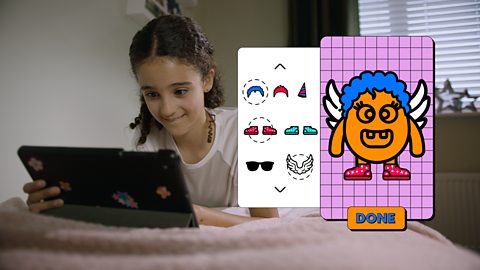
What are online relationships? video
Explains the different types of relationships we might have online, and some of the risks involved when talking to people online we don’t know.
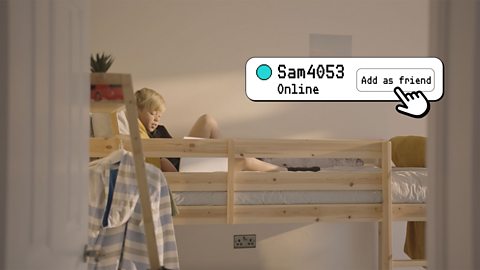
What is online reputation? video
Explains how the things we do online create a digital footprint, and the possible positives and negatives involved when leaving this footprint.
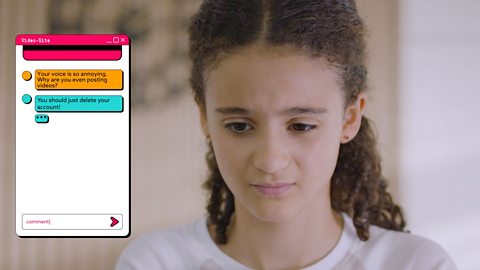
What is online bullying? video
Introduces the topic of online bullying and what this could look like, as well as giving some ideas of what to do if you encounter it.
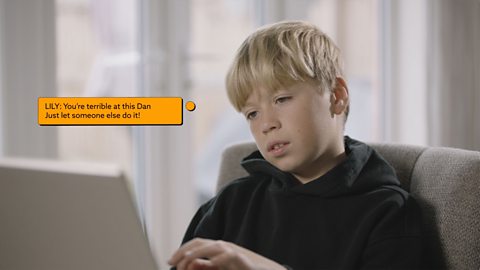
How to find reliable information online. video
An introduction to the topic of managing online information – discussing the positives and negatives.
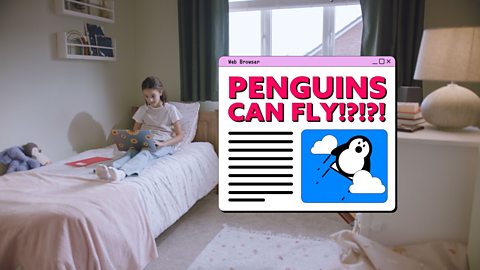
How to balance your screen time – health and wellbeing online. video
Explains that going online can have positive and negative impacts, so we need to balance our time online and offline.
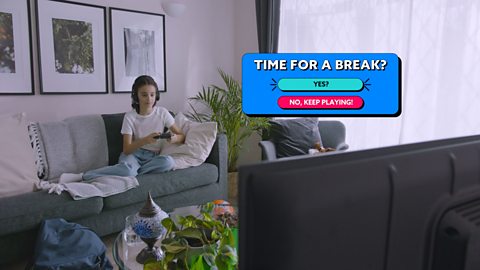
How to keep your information safe online video
Introduces the topic of privacy and security, explaining that personal information shouldn’t be shared online and that passwords should be strong.

What is copyright and ownership? document
Introduces the topic of 'copyright and ownership', explaining that the creative content that people post online belongs to them.
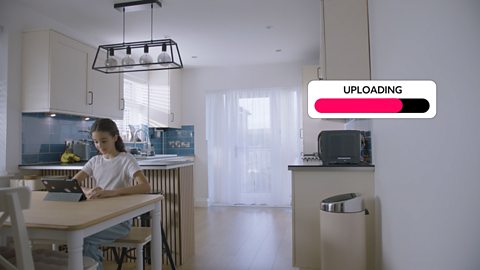
Phishing: Safer Internet Day resources for 7-11-year-olds. video
Introduces the topic of phishing, explaining that it is when someone tries to trick you into giving out your personal details online, like passwords or bank information.
